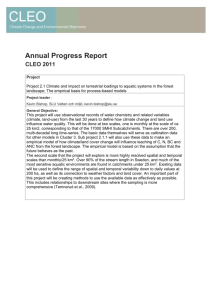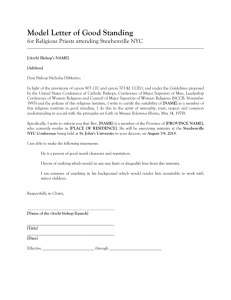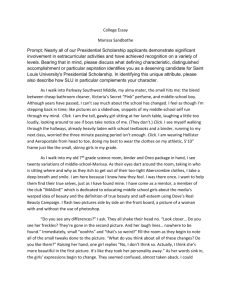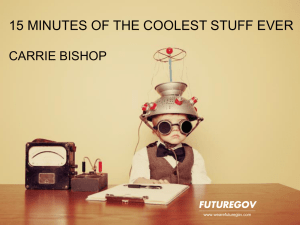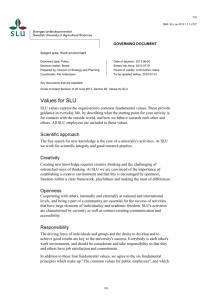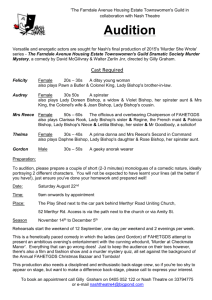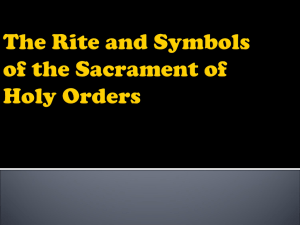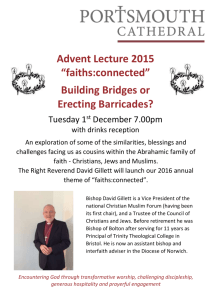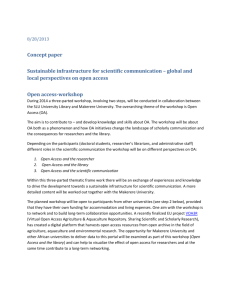Climate change effects on forest ecosystems
advertisement
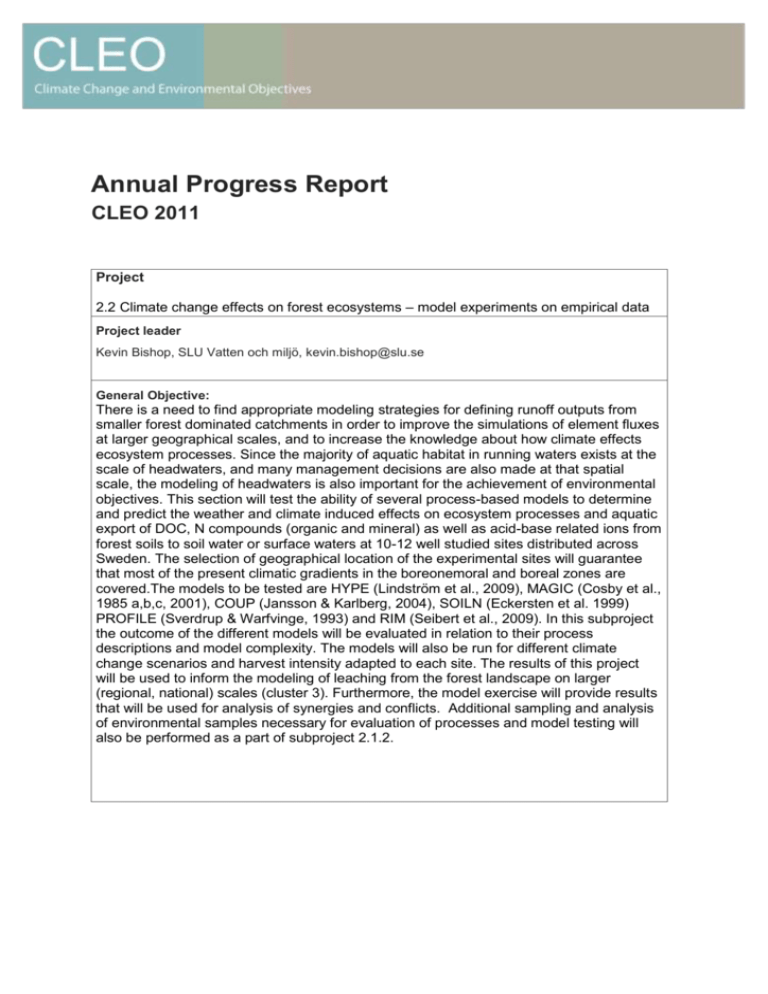
Annual Progress Report CLEO 2011 Project 2.2 Climate change effects on forest ecosystems – model experiments on empirical data Project leader Kevin Bishop, SLU Vatten och miljö, kevin.bishop@slu.se General Objective: There is a need to find appropriate modeling strategies for defining runoff outputs from smaller forest dominated catchments in order to improve the simulations of element fluxes at larger geographical scales, and to increase the knowledge about how climate effects ecosystem processes. Since the majority of aquatic habitat in running waters exists at the scale of headwaters, and many management decisions are also made at that spatial scale, the modeling of headwaters is also important for the achievement of environmental objectives. This section will test the ability of several process-based models to determine and predict the weather and climate induced effects on ecosystem processes and aquatic export of DOC, N compounds (organic and mineral) as well as acid-base related ions from forest soils to soil water or surface waters at 10-12 well studied sites distributed across Sweden. The selection of geographical location of the experimental sites will guarantee that most of the present climatic gradients in the boreonemoral and boreal zones are covered.The models to be tested are HYPE (Lindström et al., 2009), MAGIC (Cosby et al., 1985 a,b,c, 2001), COUP (Jansson & Karlberg, 2004), SOILN (Eckersten et al. 1999) PROFILE (Sverdrup & Warfvinge, 1993) and RIM (Seibert et al., 2009). In this subproject the outcome of the different models will be evaluated in relation to their process descriptions and model complexity. The models will also be run for different climate change scenarios and harvest intensity adapted to each site. The results of this project will be used to inform the modeling of leaching from the forest landscape on larger (regional, national) scales (cluster 3). Furthermore, the model exercise will provide results that will be used for analysis of synergies and conflicts. Additional sampling and analysis of environmental samples necessary for evaluation of processes and model testing will also be performed as a part of subproject 2.1.2. Short description of activities 2011: The project group has had two 2-days workshops, complemented by monthly telephone meetings. Results from the group were also presented at the workshop “Försurning: Var problemet inte löst?” in November 2011. The major accomplishments by the group in 2011 were completion of the first comprehensive modelling report (Deliverable 2.2) This compared how different models simulated the effects of weather and land use change on key water quality variables (C, N, P, pH, and ANC) in the observed time series from well documented catchments using a common set of criterion for evaluating the simulations. The performance of the different models varied considerably. To begin with, only the HYPE and multivariate models were applied to all the sites. When modeling the observations none of the more complex models were able to achieve calibrations to any of the chemical constituents that had a Nash Sutcliffe Efficiency (NSE) better than zero (i.e. better than predicting the average). When considering only annual values, the NSE was still sub-zero in the cases examined, with the exception of MAGIC which did well at modeling acidification parameters at the annual scale. (MAGIC however, was only applied at the annual time-step.) Although the complex models did not achieve good statistical indices for today’s conditions, they include process descriptions for nitrogen and carbon that may be helpful in assessing the combined effects of factors such as increased temperature and intensified fertilization. The simpler models (including a straight multivariate statistical model) were able to achieve positive NSE values for the calibrations. The validations were also positive for most constituents and sites in the validation. The experience from this initial exercise will be used to improve the next modeling report. Several areas where work will focus are: 1) consistency and completeness in the modeling of calibration and validation periods. 2) assessing the seasonal and annual scale as well as the current evaluation of individual observations. 3) Examining the utility of the models for CLEO’s purposes in ways that go beyond traditional measures such as NSE. This will include looking at how the models perform when comparing wet or dry years, for instance. Deliverables 2011: D2.2.1 Database copilation for model application at well documented sites included in CLEO programme (PMK5, IM, Balsjö, Sniptjärn, Masbyn, Risfallet, Gårdsjön and Asa). )12). These data have been compiled in Dropbox and used. A catalog linking specific model inputs to the relevant files is being prepared Deliverables 2011 D2.2.2 Model assessment report – results of model runs on well documented sites (18) Delivered. D2.2.3 Evaluation report on parameterization for regional/national model applications (24) New delivery date April 2012. Deliverables 2012 D2.2.4 Strategy for regional/national model parameterisation for Cluster 3. (30) Additional staff involved in project: Annemieke Gärdenäs, Martin Rappe George, Filip Moldan, Berit Arheimer, Charlotta Pers, Cecilia Akselsson, Johan Temnerud, Mattias Winterdahl Co-operation outside CLEO: Future Forests, FORMAS ForWater SLU FOMA Försurning Reports and publications: Winterdahl, M., J. Temnerud, M. N. Futter, S. Lofgren, F. Moldan, and K. Bishop (2011), Riparian Zone Influence on Stream Water Dissolved Organic Carbon Concentrations at the Swedish Integrated Monitoring Sites, Ambio, 40(8), 920-930. Winterdahl, M., M. Futter, S. Kohler, H. Laudon, J. Seibert, and K. Bishop (2011), Riparian soil temperature modification of the relationship between flow and dissolved organic carbon concentration in a boreal stream, Water Resources Research, 47. Oral presentations: Co-sponsor of ”Försurning: Var problemet inte löst? Rapporter från SLU Fortlöpande Miljöanalys, Future Forests, ForWater CLEO. Nov 15, 2011. 50 people in attendance. Invited Keynote (Bishop)– Gordon Research Conference on Catchment Science July 2011. “Looking backwards to see hazards ahead in murky boreal waters: An endorsement with reservations” Invited Speaker (Bishop), – University of Basel. Department of Environmental Sciences. March 2011. “Water through the looking glass of landscapes: can we see the future in the different climate?”
